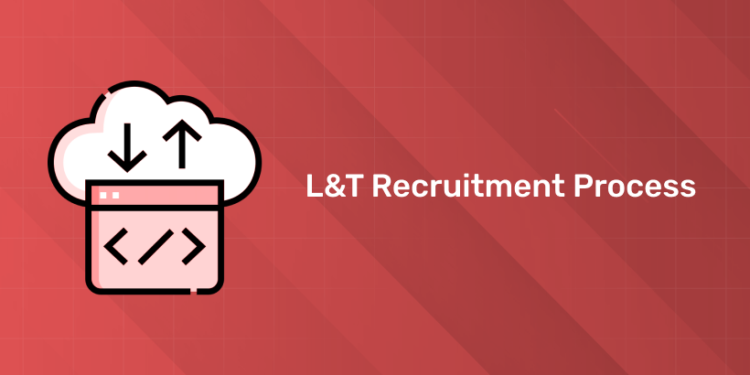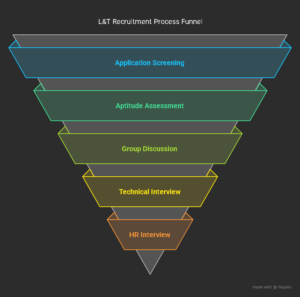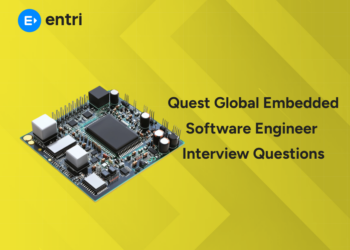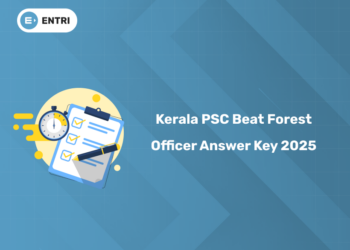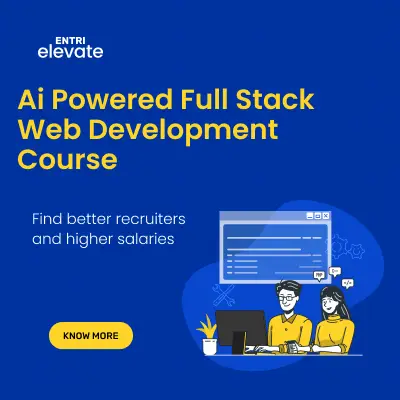Table of Contents
Introduction
If you’ve ever dreamed of joining Larsen & Toubro, you’re not alone. Each year, thousands of hopefuls submit their applications, yet only a select few make the cut. My engineering buddy Raj once told me over coffee, “Getting into L&T was the hardest but most rewarding challenge of my career.” He wasn’t exaggerating.
L&T doesn’t just hire employees—they hunt for problem-solvers, innovators, and people with grit. Their recruitment process reflects this philosophy. It’s tough, sometimes frustratingly complex, but ultimately designed to find professionals who can handle the pressure of billion-dollar projects. So let’s roll up our sleeves and dig into what it really takes to land a job at this engineering powerhouse.
Get hands-on with our python course – sign up for a free demo!
About the L&T Recruitment Process
1: Which of the following data structures allows elements to be added and removed in a Last-In, First-Out (LIFO) order?
Company Overview
L&T isn’t just another company—it’s practically a national institution. Born in 1938 from the partnership of two Danish engineers, Larsen & Toubro has grown from humble beginnings into a behemoth that touches almost every aspect of Indian infrastructure.
Drive on a highway, ride the metro, flip a switch, or visit a manufacturing plant—chances are, L&T had something to do with it. Their footprint spans defense, construction, power transmission, heavy engineering, IT, and financial services across 30+ countries. Think of them as the company that builds the things that make modern life possible.
What blew my mind when researching this article was the sheer scale of their workforce—over 45,000 professionals from virtually every engineering and management discipline imaginable. That’s not just a company; that’s a small city of talent.
What most people don’t realize is that despite its size, L&T maintains an entrepreneur’s heart. My former classmate who works in their hydrocarbon division told me, “Each project feels like running your own business. They give you the resources, but also the freedom to execute your vision.”
Work Culture
“The L&T way” isn’t just corporate jargon—it’s something employees reference constantly. When I interviewed several professionals for this piece, this phrase kept coming up.
Karthik, a project manager with 8 years at L&T, explained it best: “It’s hardcore engineering mixed with military-like discipline and a strange creative freedom. Sounds contradictory, right? But it works.”
The company operates on a fascinating blend of old-school values and progressive practices. Merit trumps seniority. Fresh graduates sometimes lead critical initiatives while veterans provide guidance. Everyone gets their hands dirty—literally. Even senior managers regularly visit construction sites, climb scaffolding, and engage with ground realities.
Another distinctive aspect is their focus on continuous learning. My neighbor’s daughter joined their Graduate Engineering Training program last year and described it as “like getting a second degree while earning a salary.” They invest heavily in developing their people through formal training, mentorship, and international exposures.
The catch? L&T demands excellence. The pressure can be intense. The hours can be long. Site postings might take you to remote corners of the country. But for those who thrive in challenging environments, the growth opportunities are extraordinary.
L&T Official Resources
Before you do anything else, bookmark L&T’s careers page. Unlike many companies where job listings are an afterthought, L&T maintains a comprehensive portal with everything from entry-level positions to specialized roles across their various business verticals.
I check their careers section monthly and notice they typically update it every two weeks with fresh openings. Their job alerts feature is particularly useful—set your preferences once and receive notifications for matching positions.
Beyond job listings, explore their employee testimonials section. These aren’t the typical PR-polished stories you might expect. They offer genuine insights into project challenges, learning curves, and career progression paths.
Explore Free Coding Courses!
Take your first step toward mastering in-demand skills, acing interviews, and securing top-tier jobs with Entri's free coding courses.
👉 Explore Free Courses NowL&T Recruitment Process: Overview
1. Application Screening
Getting past L&T’s initial screening is surprisingly tough. A campus recruitment coordinator confided to me that they typically eliminate 70-80% of applications at this stage.
What separates successful applications? It’s not just grades. My former roommate with perfect GPA got rejected, while another friend with average scores but impressive project work got through.
L&T’s recruiters hunt for signals of practical problem-solving ability. That robotics competition you participated in? The app you developed? The industrial training where you optimized a manufacturing process? These carry more weight than you might think.
For experienced candidates, they scrutinize the complexity of projects handled, leadership instances, and adaptability across different business contexts. One interviewer bluntly told me, “We’re looking for people who build things that work, not just people who understand theories.”
2. Aptitude and Technical Assessment
L&T’s aptitude tests are legendary for their difficulty. Forget standard questions—they design scenarios that test both knowledge and application.
A civil engineering graduate described her experience: “I walked in expecting typical structural analysis problems. Instead, they gave us a case study about an actual bridge failure and asked us to identify possible causes and remediation strategies.”
The test typically covers:
- Logical reasoning (more complex than your typical CAT/GMAT patterns)
- Numerical ability (with industry-relevant applications)
- Verbal comprehension (often using technical documents)
- Domain-specific technical knowledge
The pass percentage varies by role and applicant pool, but rarely exceeds 40%. Time management is crucial—many capable candidates fail simply because they couldn’t complete the assessment.
3. Group Discussion
If the technical assessment weeds out the underprepared, the GD round exposes those who can’t collaborate. This isn’t your typical campus placement GD where the loudest voice wins.
Kavita, now a senior engineer at L&T’s power transmission division, shared her experience: “They gave us a failed project scenario with limited information and asked us to develop a recovery plan. What was fascinating was how the moderators were taking notes not just when we spoke, but when we listened.”
Topics range from industry-specific challenges to broader themes like sustainability in construction or technology integration in traditional engineering. What they’re really assessing is:
- Can you articulate complex ideas simply?
- Do you build on others’ thoughts or just push your own agenda?
- Can you disagree professionally without becoming disagreeable?
- Do you bring unique perspectives to the table?
The dynamic is intense but revealing. One HR manager told me they sometimes deliberately include strongly opinionated moderators to see how candidates respond to authority challenges—a common situation in high-stakes projects.
4. Technical Interview
This is where L&T separates the theoreticians from the practitioners. Technical interviews typically last 45-90 minutes and dive deep into your fundamental understanding.
Ravi, who cleared this round for a mechanical engineering position, recalled: “They asked me to design a basic hydraulic system on the spot. When I finished, they introduced a constraint that made my design unworkable and asked me to adapt it. Then they introduced a budget constraint. It was like playing engineering chess.”
Expect questions about:
- Your major projects and your specific contributions
- Troubleshooting scenarios related to your field
- Basic engineering principles and their practical applications
- Industry standards and best practices
- Your approach to learning new technologies
Interviewers often include both HR representatives and senior engineers from the department you’re applying to. Their questions build upon each other, testing not just what you know but how quickly you can apply that knowledge to new situations.
5. HR Interview
Don’t be fooled by the “HR” label—this final round is far from a formality. While less technically rigorous, it often determines whether you receive an offer.
The HR interview evaluates cultural fit, long-term potential, and alignment with company values. Key areas they probe include:
- Your willingness to relocate (a major consideration given L&T’s nationwide projects)
- Your understanding of L&T’s businesses beyond your specific role
- Your career aspirations and how they align with the company’s trajectory
- Your approach to work-life balance in demanding project environments
- Your motivation for joining L&T specifically versus competitors
One successful candidate noted: “They asked me to describe a time I failed at something important and what I learned. It wasn’t about having a perfect answer but showing self-awareness and growth mindset.”
6. Offer and Onboarding
If you make it through this gauntlet, congratulations! Offers typically arrive within 2-4 weeks of the final interview, though campus recruitment timelines may vary.
The onboarding experience is comprehensive, often beginning with a company-wide orientation followed by business-specific training. New engineers frequently start with a rotation program across different project types and departments, giving them exposure to various aspects of the business.
L&T assigns mentors to new hires—usually professionals with 5+ years of experience who provide guidance on both technical and cultural aspects of the organization.
Get hands-on with our python course – sign up for a free demo!
L&T Eligibility Criteria & Salary
Eligibility Requirements
L&T maintains different eligibility thresholds across business verticals, but certain patterns hold true across the board:
For Fresh Graduates: The academic cutoff is stringent—typically 60-65% consistently throughout your academic career (10th, 12th, and degree), with no history of backlogs. Some specialized divisions like L&T Technology Services might set the bar higher at 70%.
Engineering branches in highest demand include Mechanical, Civil, Electrical, Electronics, and Computer Science, though they recruit from other disciplines based on business needs.
What many candidates miss is the importance of relevant internships and projects. A campus recruiter shared: “We’d rather take someone with 65% marks and hands-on project experience than someone with 85% who’s never applied their knowledge.”
For Experienced Professionals: Beyond relevant work experience (typically 2-8 years for mid-level positions), L&T evaluates:
- Project complexity and scale handled
- Client interaction experience
- Team management capabilities
- Domain expertise relevant to their business verticals
The Unspoken Requirements: Having interviewed several L&T professionals, I’ve identified a few unofficial criteria that matter:
- Geographical flexibility (willingness to relocate to project sites)
- Resilience under pressure (projects often have tight deadlines)
- Practical problem-solving approach
- Professional communication skills
- Safety-consciousness (especially for site-based roles)
Salary Structure
L&T’s compensation packages are competitive within the industry, though they vary significantly based on role, business vertical, and experience level.
For Fresh Graduates: Graduate Engineer Trainees typically receive packages ranging from ₹4.5-6.5 lakhs per annum, depending on specialization and placement location. Management Trainees generally command ₹6-8 lakhs, while Post Graduate Engineer Trainees see offers in the ₹7-9 lakh range.
What most job seekers don’t realize is that site-based roles often include additional allowances that can significantly boost the effective compensation.
For Experienced Professionals: Mid-level engineers with 3-5 years of experience typically earn between ₹8-12 lakhs annually. Those reaching senior engineer or project manager levels (6-10 years) can expect ₹12-18 lakhs, with higher compensation for specialized skills or critical project roles.
Leadership positions are highly competitive, with compensation packages often negotiated individually based on expertise and track record.
The Complete Package: Beyond base salary, L&T offers:
- Performance-linked variable pay (typically 10-15% of annual salary)
- Comprehensive medical coverage for employees and dependents
- Retirement benefits including provident fund and gratuity
- Housing and transportation allowances for certain roles
- Professional development support
- Relocation assistance for transfers
An interesting aspect is their rewards for innovation. Engineers who develop patentable solutions or cost-saving methodologies receive special recognition and financial incentives—something not widely publicized but appreciated by employees.
Preparation Tips for the L&T Recruitment Process
For Aptitude and Technical Assessments
After speaking with recent hires, I’ve compiled these targeted preparation strategies:
- Focus on Application Over Theory: Rather than memorizing formulas, practice applying concepts to real-world problems. L&T’s questions rarely test theoretical knowledge in isolation.
- Develop Speed With Accuracy: The assessments are deliberately time-constrained. Practice timed tests regularly, gradually increasing difficulty.
- Master These Specific Areas:
- For Civil Engineers: Structural analysis, construction planning, material properties and testing methods
- For Mechanical Engineers: Thermodynamics, manufacturing processes, machine design, fluid mechanics
- For Electrical Engineers: Power systems, control systems, electrical machines
- For Computer Science: Data structures, algorithms, database management, networking basics
- Study Industry Standards: Unlike academic exams, L&T often references industry codes and standards. Familiarize yourself with basic IS codes (for civil), ASME standards (for mechanical), or IEEE standards (for electrical).
- Read Industry Publications: Regular reading of publications like Engineering News Record or domain-specific journals builds contextual knowledge that helps in scenario-based questions.
A recent hire revealed: “I spent too much time reviewing textbooks and not enough on application. What helped most was joining online forums where engineers discussed real-world problems.”
For Group Discussions
Having observed several L&T group discussions, I can offer these practical tips:
- Master the First 30 Seconds: The opening moments often set your trajectory for the entire discussion. Prepare concise, value-adding introductory statements for common topics.
- Develop a Point-Evidence-Impact Structure: When speaking, clearly state your point, provide supporting evidence, then explain the impact or implication. This structure signals organized thinking.
- Practice the “Yes, And…” Technique: Instead of directly contradicting others (which creates defensiveness), acknowledge their input before adding your perspective. Example: “Yes, cost optimization is crucial, and we should also consider the timeline implications…”
- Prepare for These Common Topics:
- Infrastructure challenges in developing nations
- Technology integration in traditional engineering
- Sustainability vs. cost considerations
- Public-private partnerships in infrastructure development
- Safety protocols in high-risk construction environments
- Record and Review Your Practice Sessions: Video yourself during practice GDs to identify unconscious habits like interrupting others or using filler words.
One successful candidate shared: “I noticed I had a habit of dismissing ideas quickly. Working on active listening completely changed how I performed in the actual GD.”
For Technical Interviews
Based on conversations with L&T interviewers and successful candidates:
- Revisit Your Fundamentals: L&T interviewers intentionally start with basics before progressing to complex topics. A shaky foundation immediately raises red flags.
- Prepare a Technical Portfolio: Compile detailed documentation of your projects, including challenges faced and solutions implemented. Being able to discuss specific technical decisions demonstrates depth of understanding.
- Practice Whiteboarding Solutions: Many technical interviews involve sketching designs or solutions on the spot. Practice explaining your thought process while drawing or diagramming.
- Develop a Systematic Problem-Solving Approach:
- Clarify requirements and constraints before proposing solutions
- Consider multiple approaches before selecting one
- Explain trade-offs between different solutions
- Address potential failure points proactively
- Be Honest About Knowledge Gaps: When faced with unfamiliar topics, demonstrate your learning approach rather than bluffing. One interviewer noted: “I’d rather hear ‘I haven’t worked with that technology, but here’s how I would approach learning it’ than a fabricated answer.”
Explore Free Coding Courses!
Take your first step toward mastering in-demand skills, acing interviews, and securing top-tier jobs with Entri's free coding courses.
👉 Explore Free Courses NowFor HR Interviews
The last hurdle is often the trickiest. I’ve talked with folks who aced the technical rounds but stumbled here. Don’t let that be you:
- Dig Into What L&T’s Building Right Now: Sure, knowing when they were founded matters, but what got me through was mentioning their Metro Rail work in Bangalore and water treatment project in Gujarat. HR folks light up when you show you’ve done your homework on stuff they’re working on today.
- Tell Your Story—The Real One: My buddy Vikram nailed this. He didn’t just list skills; he talked about how growing up watching his dad fix everything around the house led him to mechanical engineering, and how L&T’s massive machinery projects were exactly where those childhood fascinations could become professional achievements. No fancy words—just honest connections.
- Have Those “War Stories” Ready: They’ll throw scenarios at you, so keep some examples in your back pocket about:
- That time your project team was at each other’s throats and how you smoothed things over
- When the client changed requirements three days before deadline and you still delivered
- The technical disaster you faced that seemed impossible until you figured out that one weird solution
- How you adjusted when your perfect plan got thrown out the window
- That incident where you spotted a safety issue nobody else caught
- Own Your Weak Spots: My three-job history in four years was a red flag. Instead of hiding it, I explained how each move taught me something crucial that made me better suited for L&T. The interviewer actually nodded and said, “That makes sense now.”
- Flip the Table With Smart Questions: My winning move? Asking the HR manager, “How does L&T balance innovation with tried-and-true engineering approaches on conservative infrastructure projects?” She put down her notes and we had a real conversation for the next ten minutes.
I remember Deepa telling me how her HR interview went. “They looked at my resume and noticed I had another offer from their biggest competitor with better pay. When they asked why I preferred L&T, I mentioned their hydro project in Bhutan and how I’d specialized in hydraulic structures. The interviewer actually smiled—I could tell he knew I wasn’t just there for a paycheck.”
Get hands-on with our python course – sign up for a free demo!
Conclusion
Getting into L&T isn’t about cracking some code or gaming their system. You can’t fake your way through their process—believe me, many have tried and failed. What works is actually becoming the kind of engineer they need.
The most striking thing from my conversations with L&T veterans was how quickly they spot pretenders. One recruitment manager told me over coffee, “We can tell within five minutes who’s memorized answers versus who lives and breathes engineering challenges.” They’re hunting for the real deal—people with genuine passion for building things coupled with enough humility to know they don’t know everything.
For those just starting out, L&T isn’t just another name on your resume. It’s like engineering boot camp and graduate school rolled into one. Where else can you work on bridges, power plants, defense systems, and smart cities all under one company banner? For those with experience elsewhere, L&T offers the chance to scale up—to tackle projects that don’t just serve clients but transform regions and impact millions.
The path to an L&T offer letter isn’t smooth or easy. It’s deliberately challenging because their work demands it. But I’ve yet to meet an L&T engineer who regrets the journey. As Suresh, who’s been with them since 2008, told me while showing pictures of a massive port he helped build, “L&T taught me to think beyond structures. We’re not just putting steel and concrete together—we’re building the backbone of economies that will function for generations.”
Take that first step. Check out their careers page. Find something that matches what you bring to the table. Then prepare like your dream job depends on it—because it does. For those who make it through, L&T opens doors to projects most engineers only read about in textbooks.
The question isn’t whether L&T is worth the effort. The question is: are you ready to become the kind of professional who thrives there?
Explore Free Coding Courses!
Take your first step toward mastering in-demand skills, acing interviews, and securing top-tier jobs with Entri's free coding courses.
👉 Explore Free Courses NowFrequently Asked Questions
What academic percentage is required to apply for entry-level positions at L&T?
L&T typically requires a consistent academic record with minimum 60-65% marks throughout (10th, 12th, and degree). However, this can vary between business verticals, with some technical divisions like L&T Technology Services setting higher thresholds around 70%. They evaluate your entire academic journey, not just your final degree percentage, so consistency matters. While not officially stated, candidates with project experience and practical skills sometimes receive consideration even with slightly lower percentages.
Does L&T recruit from all engineering branches, or do they focus on specific disciplines?
While L&T recruits most heavily from core engineering branches (Civil, Mechanical, Electrical, Electronics, and Computer Science), they also hire from other disciplines based on business requirements. Specialized divisions like L&T Infotech focus on computer science graduates, while their hydrocarbon division seeks chemical engineers. Some business verticals like L&T Construction occasionally recruit from non-engineering backgrounds like Economics or Commerce for project management roles, though this is less common.
How long does the entire L&T recruitment process typically take from application to offer?
For campus placements, the process is relatively streamlined, usually completed within 1-2 months from initial application to final offer. For lateral hiring (experienced professionals), the timeline extends to 2-3 months, especially for senior positions that require multiple rounds of technical assessment and leadership evaluation. Project-based urgent recruitments can sometimes be expedited, but comprehensive evaluation remains a hallmark of their hiring approach regardless of timeline pressures.
Are there any preparation resources specifically for L&T's technical assessment?
Unlike some companies, L&T doesn’t publish official preparation materials. Your best resources are standard engineering reference books relevant to your discipline and previous years’ questions shared informally by past applicants. Engineering forums like GateOverflow and GeeksforGeeks contain discussions about L&T’s technical assessment patterns. Industry publications relevant to your field provide context for their application-based questions. Several coaching institutes in major engineering hubs offer specialized preparation modules for L&T recruitment, though their quality varies considerably.
Does L&T consider candidates with employment gaps or backlog subjects?
While L&T traditionally prefers candidates with uninterrupted academic and professional records, their stance has become somewhat more flexible in recent years, particularly for experienced hires with specialized skills. Academic backlogs are still viewed cautiously for campus recruitments, but candidates who have cleared all backlogs and demonstrate exceptional project work might receive consideration. Employment gaps require clear, honest explanation during interviews. Candidates returning to the workforce after career breaks (especially women returning after maternity gaps) can apply through L&T’s diversity initiatives.
What kind of questions are typically asked in L&T's group discussion rounds?
L&T’s group discussions typically involve industry-relevant topics rather than general awareness subjects. Recent GD topics have included: “The impact of automation on traditional engineering jobs,” “Balancing environmental concerns with infrastructure development,” “Public-private partnerships in large infrastructure projects,” “Safety protocols versus project timelines in construction,” and “The future of renewable energy in India’s power grid.” They evaluate both content knowledge and communication dynamics, paying particular attention to how candidates build on others’ ideas rather than simply advancing their own viewpoints.
Is relocation flexibility really as important as people say for L&T positions?
Yes, geographical flexibility remains crucial for many L&T roles, particularly in their construction, heavy engineering, and power transmission businesses where projects span across India and international locations. While headquartered in Mumbai, their projects might take you anywhere from remote Northeastern states to Middle Eastern countries. Corporate and IT roles offer more location stability, typically based in major metropolitan cities. Some business units have introduced “home location preference” systems for experienced professionals after completing certain tenure milestones, but early-career engineers should expect 2-3 relocations within their first five years.
What's the difference between joining L&T as a GET (Graduate Engineer Trainee) versus direct recruitment?
The GET program is L&T’s structured entry-level pathway featuring formal training periods, rotational assignments across departments, mentorship programs, and periodic assessments. Direct recruits join specific roles immediately without this formalized rotation. GETs typically undergo a 12-18 month training period before final department placement, while direct recruits receive only basic orientation before assuming responsibilities. Career progression can be slightly faster for outstanding performers in the GET program due to their cross-functional exposure, though this advantage diminishes over time as direct recruits build specialized expertise.
How does L&T's interview process differ for experienced professionals versus fresh graduates?
For experienced professionals, L&T’s process places greater emphasis on demonstrated project expertise, leadership capabilities, and business acumen. Technical assessments become more specialized, often involving case studies related to previous project challenges. The number of interview rounds typically increases, with separate functional, technical, and leadership evaluations. Negotiations around compensation and role specifics form a significant part of the process. Fresh graduate recruitment follows a more standardized pattern with emphasis on fundamental knowledge, learning potential, and cultural fit rather than specialized expertise.
What growth opportunities exist within L&T after joining?
L&T offers multiple growth trajectories depending on your interests and strengths. Technical specialists can progress through expert tracks, eventually becoming Technical Directors or Chief Engineers without necessarily managing large teams. Management-oriented professionals can advance through project management roles into business unit leadership. Lateral movement between L&T’s diverse business verticals is possible after demonstrating strong performance, though typically requires 3-5 years of experience in your initial division. Their leadership development programs identify high-potential employees for accelerated growth, providing specialized training, challenging assignments, and mentorship from senior leaders. Many current business heads joined as graduate trainees, demonstrating the company’s commitment to long-term career development.


